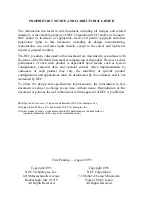
Operating Instructions
4
01056G
WARNING: ALWAYS SHIELD EYES WHEN
WORKING NEAR BATTERIES. DO NOT PUT
WRENCHES OR OTHER METAL OBJECTS
ACROSS BATTERY TERMINAL OR BATTERY
TOP. ARCING OR EXPLOSION OF THE
BATTERY CAN RESULT!
Charger will turn ON one to three (1-3) seconds
after completion of the last of the above three
actions indicated by the glowing YELLOW light
and the charger ammeter indicating initial
charge current.
If the YELLOW light does not illuminate and the
Power switch is in the "ON" position, the AC
outlet is not live or an open circuit exits in the
wheelchairs internal circuitry. Test for a live AC
outlet by connecting a suitable household
appliance to the specific outlet. If the outlet tests
live, then the fault is in the wheelchair wiring.
Take the wheelchair to your dealer to have the
fault corrected (see Troubleshooting).
4.
Monitor ammeter for correct charge rate. Initial
charge rate should be between 7 to 9 amps. As
the battery reaches approximately 70% of full
charge, the charge rate decreases to a reading
determined by the "BATTERY TYPE" switch
setting and the condition of the batteries.
Replaceable Electrolyte Deep Cycle Batteries
With healthy batteries, the charging current will
decrease to between 2 to 4 amps and remain
there until the charger turns off. As replaceable
electrolyte deep cycle batteries lose capacity,
the charge rate may no longer decrease to this
reading. The charger will still determine when
the batteries are as charged as they are capable
of being and will turn off. When battery capacity
has decreased to where the charger is no longer
able to taper down to less than 4 amps, or the
batteries will no longer perform as desired they
should be replaced.
Gel Cell and Sealed Deep Cycle Batteries
The charging current will decrease to near zero
and remain there until the charger turns off. Gel
cell deep cycle batteries will still taper to near
zero charge current even as they wear out and
lose capacity and range. As sealed deep cycle
batteries lose capacity and range, the charge
current may no longer decrease to this low a
reading. The charger will still determine when
the batteries are as charged as they are capable
of being and turn off. When the batteries will no
longer perform as desired, they should be
replaced.
Charger is equipped with a temperature sensor
which automatically turns charger off if it
overheats. Should charger turn off before the
batteries are fully charged, check to be sure all
ventilation openings are free from obstructions.
After charger cools down to a safe temperature,
it will automatically restart. If charger repeatedly
overheats, refer to a qualified service agent.
5.
Charger turns off automatically when batteries
are fully charged. Charge time varies with
battery size and depth of discharge. Allow 8
hours for normal charging. Larger batteries
(greater than 85 ampere-hours) or severely
discharged batteries may require up to 14 hours
to be properly charged and equalized. If the
charger operates for 14 hours and is unable to
fully charge the batteries, an internal timer turns
the charger off, extinguishes the YELLOW
charge light, and turns the RED fault light on.
6.
After the charger has turned off, move the
POWER switch to "OFF", disconnect AC cord
first, then the DC output cord from the
Wheelchair charging receptacle.
CAUTION: TO AVOID DAMAGE TO THE
CHARGER CORD AND BATTERY CONNECTOR,
DISCONNECT BY GRASPING THE PLUG
HANDLE OR BODY AND PULLING IT STRAIGHT
OUT OF THE BATTERY CONNECTOR. DO NOT
PULL ON THE CHARGER CORD. DO NOT
TWIST, ROCK OR PULL THE PLUG SIDEWAYS.
WARNING: TO PREVENT ARCING OR
BURNING NEAR THE BATTERIES, DO NOT
DISCONNECT THE OUTPUT CORD FROM THE
BATTERIES WHILE THE CHARGER IS
OPERATING. IF THE CHARGE CYCLE MUST BE
INTERRUPTED, FIRST SLIDE THE POWER
SWITCH TO OFF, THEN DISCONNECT AC CORD,
AND FINALLY THE OUTPUT CORD FROM THE
BATTERIES. KEEP SPARKS, FLAME, AND
SMOKING MATERIALS AWAY FROM
BATTERIES. NO SMOKING.
WARNING: DO NOT LEAVE THE DC
OUTPUT CONNECTOR PLUGGED IN WHILE
UNATTENDED FOR MORE THAN TWO (2) DAYS.
SEVERE OVERCHARGING AND DAMAGE TO
THE BATTERIES MAY RESULT IF THE
CHARGER DOES NOT TURN OFF.
PROPER CARE OF DEEP-CYCLE MOTIVE
POWER BATTERIES
Batteries used on wheelchairs are subjected to
severe deep-cycle duty on a daily basis. For this
reason, it is important that only deep-cycle batteries
be used. Although these batteries are designed to
withstand such duty, the following precautions must
be observed to obtain good performance and
maximum cycle life.


























